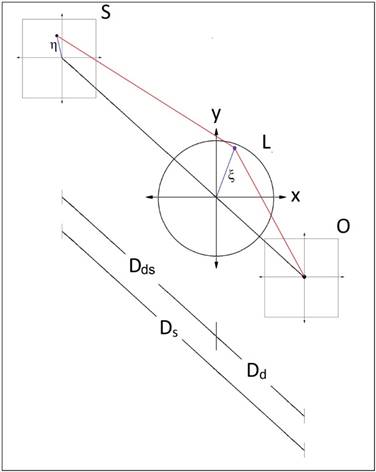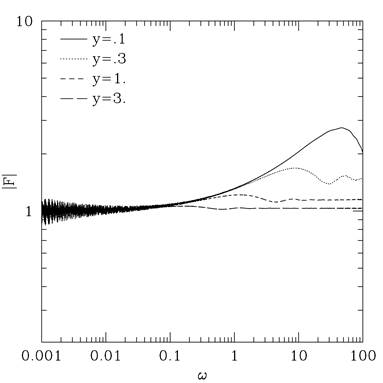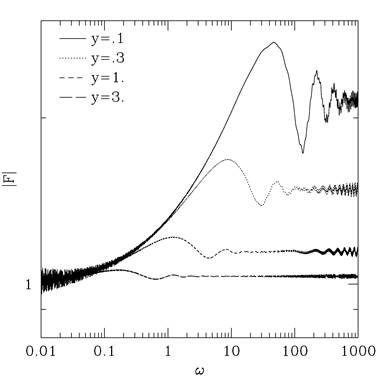1. GENERAL
Recent successes in gravitational wave detection, (Abbott et al. 2016), together with the well documented effect of gravitational lensing (GL) (Bate et al. 2018), have given strength to the idea of using general relativity to describe the gravitational field. One of the first complete treatments of the combination of these effects, i.e. the gravitational lensing of gravitational waves has been discussed by Schneider et al. (1992), it is from this source that we take most of our notation and the geometrical interpretation.
For this work we compare the amplitude ϕ of a gravitational wave when it propagates through a weak gravitational field |U| << 1 in a flat spacetime metric, see e.g.Schutz (2009):
that is, a Minkowski spacetime plus a slight disturbance. The amplitude ϕ itself satisfies the wave equation (Peters 1974),
while the deflection potential under the thin lens approximation is totally defined by its 2-dimensional lensing potential (Moylan et al. 2008),
that lies between the source and the observer. This integral is carried out over the optical axis.
Due to the fact that we limit our analysis to the case in which the wave length, λ, of the gravitational wave is larger than the Schwarzschild radius of the thin lens, we must use wave optics instead of geometric optics, as in Takahashi (2004). In this framework, the change in the amplitude is quantified via the enhancement factor or complex amplification factor (Nakamura & Deguchi 1999):
where ϕ L is the lensed wave amplitude and ϕ is the wave amplitude before lensing. We consider the magnitude of this function as a function of frequency ω and show that we can use it to distinguish between dark matter halo models.
In order to adjust our results to the frequency sensitivity of LIGO, we will limit our study to gravitational waves emitted by the source at around 200 Hz, or
If we wish to consider the cosmological effect on our results a further correction implies replacing ω with ω(1 + z), as discussed by Yoo et al. (2007) and Takahashi & Nakamura (2003), which is beyond the scope of this particular study.
The paper is organized as follows, after this brief introduction, in § 2 we summarize the basic theory of lensing, such as the geometry involved and the related distances in this phenomenon, the wave optics related to the problem (such as the enhancement factor and the time delay). § 2.1 is a very short review on constructing the thin lens potential for a spherical isothermal matter distribution, while § 2.2 reviews the same for a Navarro, Frenk and White type halo, including a simple but very effective method to fix the gauge for time delay. We close with a discussion on the effectiveness of the method to distinguish between dark matter halo models.
2. THE ENHANCEMENT FACTOR AND HALO MODELS
We now turn our attention to the particular problem of quantifying the amount of enhancement due to our specific halo models. In each case the geometrical situation is that of a source of gravitational radiation far behind a galactic halo distribution (where the space-time is deformed) and an observer on the earth, which is itself at a great distance from the halo. Since the astronomical distances are so huge we use the thin lens approximation for the halo. The approximate lens geometry is illustrated in Figure 1.

Fig. 1 The standard geometry for GL. A mass distribution located at D d , a gravitational wave source located at D s and the distance D ds between lens and source; all measured from the observer. The color figure can beviewed online.
The enhancement factor F discussed above is defined via Kirchhoff’s diffraction integral, which is obtained in Schneider et al. (1992):
Here, the function F is integrated in the lens plane, ξ is the impact parameter on the lens plane and η, the source displacement on the source plane. As defined in Schneider et al. (1992), t d is known as the Fermat potential or more commonly the time delay, and carries the information of the lens potential:
where
as discussed in Takahashi (2004) and Nambu (2013); ξ 0 is a length scale that reduces to the Einstein radius on the lens plane). With these changes, the enhancement function becomes
with the time delay
where
We can now explore different forms for the gravitational potential of the dark matter halo. The only assumption we make is that it has complete spherical symmetry. When this is the case, equation (8) becomes
To test weather our method can distinguish between halo models we will develop the enhancement function for two different mass distributions: a singular isothermal sphere (hereafter SIS) and one which reproduces the density distribution found in N-body dark matter simulations as discussed by Navarro et al. (1997, hereafter NFW).
2.1. SIS Case
The singular isothermal sphere is a very useful mass distribution model used for both stellar and galactic clusters as gravitational lenses. SISes are characterised by their surface mass density
where ξ is a radial coordinate in the lens plane and σ v is the velocity dispersion of the constituents of the halo. As Schneider et al. (1992) point out, this model was motivated to match the flat rotation curves of spiral galaxies for ξ >> 1, but breaks down for low values of ξ due to the divergence at ξ = 0. Using this density distribution we obtain the deflection potential, which can be found in Takahashi & Nakamura (2003):
where Σ cr is the critical surface mass density, as described by Bartelmann (1996)).
This procedure leads to a thin lens potential, ψ(x) = x and requires the additional phase, ϕ
m
(y) =

Fig. 2 Behavior of the enhancement factor |F| vs frequency ω, the dimensionless frequency, given by
As we can see, the closer the source is from the optic axis, the enhancement effect on the amplitude of the gravitational wave is more effective. For direct comparison, we take the same values chosen by Takahashi & Nakamura (2003) for the distance between source and lens, namely: y = 0.1, y = 0.3, y = 1.0 and y = 3.0. For low frequencies this enhancement factor is very low due to the diffraction effect (and we can also notice some noise due to our numerical method).
As the frequency increases, and for y > 0.3, we notice a considerable amount of dampening, in spite of the fact that no multiple images should form. These results allow us to calibrate our numerical procedure and motivate us to continue the study for other halo models.
2.2. NFW Case
One of the most successful density distributions found in high resolution N-body simulations is the NFW model (Navarro et al. 1997), which corresponds to a two-power density model:
Here a and ρ
0 are the pair of parameters that completely define the halo structure (and, as it turns out, ρ
0 is defined by the cosmology). Since we are interested in proving that our method may clearly distinguish between the models, we consider for this purpose the scaled radius /
We will again use (12) to obtain the deflection potential, assuming that the lens surface mass density is completely defined by (13). In this way, we find the NFW potential, in accordance with Bartelmann (1996):
In order to obtain the time delay T(x,y), we must first fix the phase, ϕ(y), such that the minimum of the time delay is zero. In contrast with the SIS case there is no simple algebraic means of doing the full calculation for arbitrary values of y; thus, we proceed to set the particular values that are of interest for this experiment (y = 0.1, y = 0.3, y = 1.0 and y = 3.0), and find the numerical value that makes zero the minimum of the time delay T(x,y). Table 1 shows the particular values obtained for our selection of y.
TABLE 1 THE PARAMETER y *
| y | ϕ m (y) |
|---|---|
| 0.1 | 0.0243401 |
| 0.3 | 0.0764808 |
| 1.0 | 0.288078 |
| 3.0 | 0.878223 |
*Which relates the axial distance from the source of gravitational waves and the corresponding values of ϕm(y) needed for the minimum of the time delay T(x,y) to be zero.
Using these values for ϕ m (y), we may now evaluate the diffraction integral (10) for the NFW model in the same way as before. Our results are shown in Figure 3, where we maintain the same frequency and enhancement range for a direct comparison.

Fig. 3 Behavior of the enhancement factor |F| vs frequency ω, the dimensionless frequency, given by
For the NFW model we can appreciate, as in the SIS case, that the amplification in the wave amplitude starts at around ω = 0.1. We notice that there is a clear difference between the models. For NFW type halos, the enhancement is less noticeable and there are fewer oscillations. We also notice considerable more dampening in this case. To confirm this behavior we plot, in Figure 4 the enhancement in a frequency range 0.01 < ω < 1000. Here we can clearly see a more dramatic dampening behavior for the NFW model. We also notice that the amplification factor is always |F| > 1, which only happens in this model. This implies that the interference between lensed gravitational waves is always constructive.

Fig. 4 As in Figure 3, with modified ranges in frequency, ω, and amplification factor, |F|, to show the distinct behavior of the NFW model.
3. CONCLUSIONS
In this paper we have shown that a detailed study using more realistic dark matter halos could provide a distinct signal for gravitational wave enhancement.
This result shows that we may use gravitational lensing of gravitational waves as a further probe for the dark matter structure in observed galaxies (or clusters of galaxies). When we compare the enhancement factor for this type of radiation, the more concentrated NFW profile can lead to a factor of up to 50%, when compared with lensing by a SIS type halo.
For this reason we propose the following observation: if we find suitable gravitational wave sources (GWS) far from any galactic field we could compare the amplitude of this radiation with the amplitude of similar sources found behind galaxy clusters. If we were able to find a sufficiently numerous population of GWS, we could compare these populations and find an empirical enhancement factor. This in turn would allow us to fine tune dark matter halo parameters.
As it is early days for GWS detection, we will continue to study the behavior of this radiation in the hope of finding further signals that may be measured as more and more data become available.











 nova página do texto(beta)
nova página do texto(beta)


